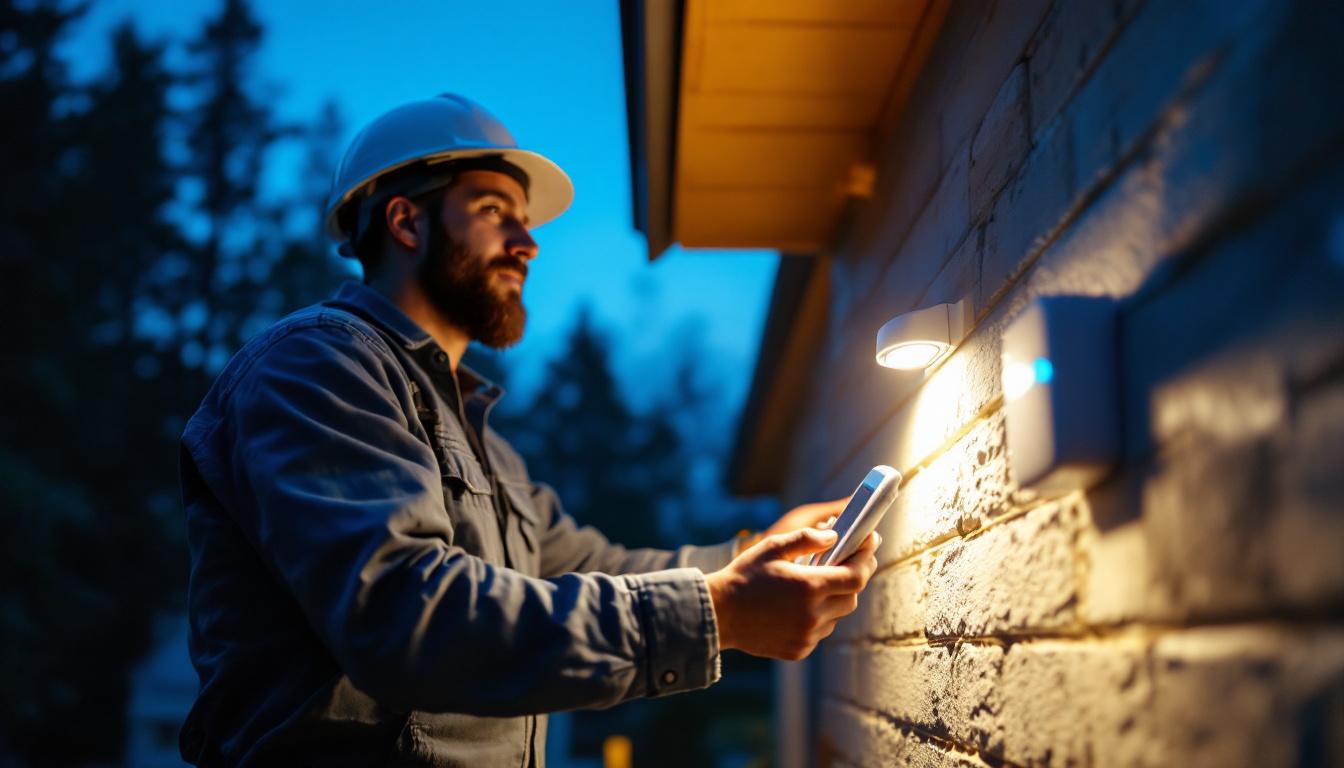
In the ever-evolving world of outdoor lighting, technology plays a pivotal role in enhancing efficiency and reducing operational costs. One of the most significant advancements in this area is the outdoor lighting sensor. These devices not only improve the functionality of lighting systems but also offer substantial cost-saving opportunities for lighting contractors. This article delves into how outdoor lighting sensors can streamline operations, reduce energy consumption, and ultimately lower costs for contractors.
Outdoor lighting sensors are devices designed to detect environmental conditions and adjust lighting accordingly. They can respond to various stimuli, such as ambient light levels, motion, and even the presence of specific objects. By integrating these sensors into lighting systems, contractors can optimize performance while ensuring that lights are only activated when necessary.
There are several types of outdoor lighting sensors available, each serving unique purposes. The most common types include:
Integrating outdoor lighting sensors into lighting systems significantly enhances operational efficiency. By ensuring that lights are only activated when needed, contractors can reduce unnecessary energy consumption. This not only lowers utility bills but also extends the lifespan of lighting fixtures, ultimately saving on replacement costs.
Moreover, sensors can be programmed to adjust lighting levels based on time of day or specific events. For example, during peak hours, lights can be set to a higher intensity, while dimming during off-peak hours. This level of control allows contractors to tailor lighting solutions to meet specific client needs while maximizing energy savings.
In addition to energy efficiency, outdoor lighting sensors can also contribute to enhanced safety and security in residential and commercial settings. For instance, motion sensors can illuminate pathways and entryways when someone approaches, deterring potential intruders and providing a sense of security for occupants. Furthermore, the integration of smart technology allows these sensors to be connected to mobile devices, enabling users to monitor and control their outdoor lighting remotely. This capability not only adds convenience but also empowers homeowners and business owners to respond quickly to any unusual activity detected by their lighting systems.
Another important aspect of outdoor lighting sensors is their role in environmental sustainability. By utilizing sensors that optimize energy use, property owners can significantly reduce their carbon footprint. Many modern sensors are designed to be compatible with renewable energy sources, such as solar panels, further enhancing their eco-friendly credentials. As communities increasingly prioritize sustainability, the adoption of outdoor lighting sensors can play a pivotal role in creating greener, more energy-efficient environments.
One of the most compelling reasons to adopt outdoor lighting sensors is the potential for significant energy savings. With energy costs on the rise, finding ways to reduce consumption is essential for both contractors and their clients.
By utilizing outdoor lighting sensors, contractors can help clients lower their electricity bills. For instance, photocells ensure that lights are only on during the night or in low-light conditions, preventing energy waste during daylight hours. Similarly, motion sensors can turn off lights in unoccupied areas, further reducing energy use.
These savings can be substantial over time, making the initial investment in sensor technology worthwhile. Contractors can present these savings as a key selling point when discussing lighting solutions with potential clients, enhancing their value proposition. Additionally, the integration of smart technology allows for remote monitoring and control, enabling clients to adjust their lighting settings from anywhere. This not only maximizes energy efficiency but also provides convenience, as clients can respond to changing conditions without needing to be physically present.
In addition to energy savings, outdoor lighting sensors contribute to reduced maintenance costs. By ensuring that lights are only on when necessary, the wear and tear on fixtures is minimized. This leads to fewer replacements and repairs, which can be a significant expense for contractors.
Furthermore, many modern sensors are designed to be durable and weather-resistant, reducing the likelihood of malfunction due to environmental factors. This reliability translates into lower maintenance calls and a more satisfied client base. Moreover, by investing in high-quality sensors, contractors can offer warranties that further assure clients of their longevity and performance. This not only builds trust but also enhances the contractor’s reputation for providing reliable and sustainable solutions. As clients experience fewer disruptions and enjoy the benefits of consistent lighting, they are more likely to recommend these services to others, creating a positive feedback loop for contractors.
Outdoor lighting sensors not only contribute to cost savings but also enhance safety and security in outdoor spaces. Properly illuminated areas deter criminal activity and provide a sense of security for residents and visitors alike. The presence of well-placed lighting can transform dark corners into safe havens, making it easier for families to enjoy their yards or for guests to navigate properties without fear. This sense of safety is particularly crucial in neighborhoods where crime rates may be a concern, as well-lit areas can significantly reduce the likelihood of incidents occurring.
Motion sensors, in particular, play a crucial role in improving visibility in outdoor spaces. By activating lights only when movement is detected, these sensors ensure that pathways, driveways, and entry points are well-lit when needed. This not only enhances safety for individuals navigating these areas but also adds an extra layer of security against potential intruders. The sudden illumination can startle would-be trespassers, making them think twice before proceeding further. Additionally, the strategic placement of these sensors can help illuminate not just the immediate vicinity but also broader areas, creating a well-lit perimeter that enhances overall security.
Moreover, the ability to adjust lighting levels based on activity can create a more welcoming environment. For instance, lights can be set to brighten when someone approaches a building, providing a sense of warmth and security. This feature is especially beneficial for businesses that want to create an inviting atmosphere for customers, as it can lead to increased foot traffic during evening hours. Furthermore, the integration of smart technology allows for customizable settings, where homeowners can program their lights to mimic their presence at home, adding an extra deterrent against potential burglars.
By offering enhanced safety features through outdoor lighting sensors, contractors can significantly improve client satisfaction. Clients are more likely to appreciate the added security and convenience provided by these systems, leading to higher retention rates and potential referrals. The peace of mind that comes with knowing their property is well-lit and secure can be a deciding factor for many homeowners when choosing contractors for future projects. As they experience the benefits firsthand, clients are more inclined to share their positive experiences with friends and family, effectively becoming brand ambassadors for the contractor’s services.
Furthermore, satisfied clients are more likely to invest in additional services, such as upgrades or expansions to their lighting systems. This not only boosts revenue for contractors but also fosters long-term relationships with clients. As technology continues to evolve, contractors can offer the latest advancements in outdoor lighting, such as solar-powered options or smart home integrations, keeping their services fresh and relevant. This ongoing relationship can lead to repeat business and a steady stream of referrals, creating a sustainable business model built on trust and satisfaction.
The integration of smart technology into outdoor lighting systems is becoming increasingly popular. Outdoor lighting sensors are often a key component of these smart systems, enabling greater control and customization.
Many modern outdoor lighting sensors come equipped with remote monitoring capabilities. This allows contractors and clients to manage lighting systems from their smartphones or other devices. Being able to adjust settings remotely provides flexibility and convenience, particularly for clients with large properties or multiple locations.
Additionally, remote monitoring can alert contractors to potential issues before they become significant problems. For example, if a sensor detects a malfunctioning light, notifications can be sent to the contractor, allowing for timely repairs and minimizing downtime.
As technology continues to advance, integrating outdoor lighting sensors into smart systems helps future-proof lighting solutions. Clients are increasingly seeking energy-efficient and technologically advanced solutions, making it essential for contractors to stay ahead of the curve.
By adopting outdoor lighting sensors, contractors position themselves as industry leaders, capable of providing innovative solutions that meet the evolving needs of their clients. This proactive approach not only enhances the contractor’s reputation but also opens doors to new business opportunities.
For lighting contractors looking to incorporate outdoor lighting sensors into their projects, understanding the implementation process is crucial. Proper installation and configuration can make a significant difference in the effectiveness of these systems.
The first step in implementation is selecting the appropriate sensors for the specific project. Factors to consider include the type of environment, the desired functionality, and the specific needs of the client. For instance, a residential property may benefit from motion sensors for security, while a commercial space may require photocells for energy efficiency.
Consulting with manufacturers and conducting thorough research can help contractors make informed decisions about which sensors will best serve their clients’ needs.
Proper installation is key to ensuring that outdoor lighting sensors function effectively. Contractors should follow manufacturer guidelines and industry best practices to achieve optimal results. This includes placing sensors in locations where they can accurately detect light levels or movement without obstruction.
Additionally, testing the system after installation is essential. Ensuring that sensors respond as intended can help identify any issues early on, allowing for prompt adjustments and minimizing client dissatisfaction.
Outdoor lighting sensors present a valuable opportunity for lighting contractors to reduce costs while enhancing the efficiency, safety, and satisfaction of their clients. By understanding the various types of sensors available and their benefits, contractors can make informed decisions that align with their business goals and client needs.
As the demand for energy-efficient and technologically advanced lighting solutions continues to grow, integrating outdoor lighting sensors into projects will not only help contractors stay competitive but also position them as leaders in the industry. Embracing this technology can lead to significant cost savings, improved client relationships, and a brighter future for lighting contractors.
Ready to elevate your lighting projects while keeping costs down? Look no further than LumenWholesale for the highest quality outdoor lighting sensors and spec-grade lighting products. Our commitment to providing contractors with superior products at wholesale prices means you can deliver exceptional value to your clients without compromising on performance. With free shipping on bulk orders, you can stock up on the best lighting solutions and enjoy the convenience and savings that come with working with a trusted partner. Take the first step towards a brighter, more efficient future and explore our collection of Wholesale Lighting at the Best Value today.

Discover the key differences between high bay and low bay LED lights with insights from seasoned lighting contractors.

Discover essential strategies for future-proofing your construction lighting projects with durable and adaptable string lights.

Discover the must-have tools and techniques for lighting contractors to create stunning solar light walkways.

Discover essential tips and best practices for lighting contractors to effectively install and maintain fire exit signs.